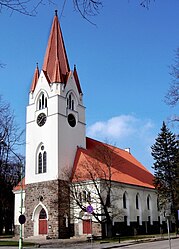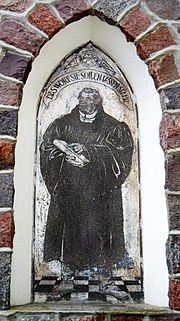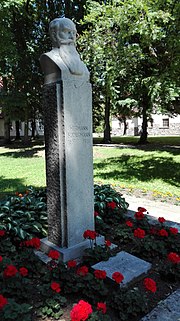Evangelical Lutheran Church of Šilutė
| Evangelical Lutheran Church of Šilutė (Šilutės evangelikų liuteronų bažnyčia) |
|
|---|---|
|
The church in 2012 |
|
| Construction year: | 1924 to 1926 |
| Inauguration: | November 10, 1926 |
| Architect : |
Curt Gutknecht interior decoration: Richard Pfeiffer |
| Style elements : | Neo-Gothic |
| Client: | Evangelical parish Heydekrug ( church province East Prussia , Church of the Old Prussian Union ) |
| Tower height: |
50 m |
| Location: | 55 ° 20 ′ 33.7 " N , 21 ° 28 ′ 1" E |
| Address: | Lietuvininkų g. 21 Šilutė Klaipėda , Lithuania |
| Purpose: | Evangelical Lutheran parish church |
| Parish: | Lietuvininkų g. 19 99134 Šilutė Tel. (+370) 441 52718 |
| Regional Church : | Evangelical Lutheran Church in Lithuania |
| Website: | silute.lelb.eu |
The Evangelical Lutheran Church Šilutė ( Lithuanian Šilutės evangelikų liuteronų bažnyčia ) is an Evangelical Lutheran church in the center of the town of Šilutė ( Heydekrug ) in Lithuania .
Church building
Building history
In the neighboring Werden (Lithuanian: Verdainė) there was already a church in the Middle Ages, where evangelical pastors have been attested since 1588. The second pastor's post in Werden was occupied by the pastor responsible for Heydekrug until 1913. After a period of independence for the Heydekrug parish, the two parishes were merged again in 1939.
In 1913 the foundation stone was laid for the Heydekrug church, which was originally intended as the Kaiser Wilhelm anniversary church. After construction stopped in World War I , construction continued in 1924 and completed in 1926. The publisher and patron Hugo Scheu ( Hugo Šojus in Lithuanian ) provided the site for the church free of charge.
Building description
The architect Curt Gutknecht built the church in the neo-Gothic style. It is a massive, plastered building with a half-retracted tower that is 50 meters high.
The interior has a barrel vault that rests on eight columns with which the galleries are connected. The altar and pulpit are made of ebony. A larger than life carved crucifix is located above the altar .
The entire artistic design of the interior of the church comes from Königsberg professor Richard Pfeiffer .
fresco
The interior of the church is dominated by the unique fresco by Richard Pfeiffer surrounding the altar niche . On an area of eighty square meters, 120 larger than life figures are depicted, including around 80 portraits of personalities from church history, who symbolize the communion of saints . In the middle above the altar Adam and Eve kneel in front of the Lamb of God , right and left biblical and historical figures join them, including the reformers Martin Luther and Johannes Calvin as well as Paul Gerhardt , Lucas Cranach and Albrecht Dürer , Johann Sebastian Bach and Georg Friedrich Handel , August Hermann Francke , Nikolaus Ludwig von Zinzendorf , Friedrich Bodelschwingh , Matthias Claudius , Amalie Sieveking and many others. The artist wanted a representation of the adoring church.
The rest of the church - above the organ and the entrances - is painted with biblical parables and symbols by the same artist.
organ
The organ was built when the church was being built. It was one of the last works by the organ builder Eduard Wittek (1857–1927) from Elbing (now Polish: Elbląg), who had taken over the organ building company from August Terletzki .
The instrument has a pneumatic action, whereby the usual playing aids are available. Until 2002 the organ was in an unplayable condition. Then an attempt was made to repair it, but in 2003 the main windshield was completely soaked due to water damage. On the occasion of a repair in the same year, a bypass was created from the blower to the gaming table.
Currently the instrument is only found to be suitable for simple accompaniment in church services. A general restoration is still pending.
Disposition of the organ
|
|
|
||||||||||||||||||||||||||||||||||||||||||||||||||||||||||||||
-
Pairing :
- Normal coupling: II / I, I / P, II / P
- Super octave coupling: II / I, I
- Sub-octave coupling: II / I
Parish
Until 1913, Heydekrug and its surrounding villages were supplied from the Werden Church (Lithuanian: Verdainė), founded in 1621 , whose second pastorate was intended for this task. In 1913 Heydekrug became independent, the parish was without patronage and there were community elections . In 1925 the parish had a total of 5500 parishioners who lived in the city and in eight surrounding parish towns. In 1939 the parishes of Heydekrug and Werden were merged to form the parish of Heydekrug-Werden.
Until 1926 the church district Heydekrug belonged to the church province of East Prussia of the Church of the Old Prussian Union (APU). After 1927, a separate regional synodal association with a special consistory was formed within the APU for the communities in the Memel region .
Today the parish in Šilutė belongs to the Evangelical Lutheran Church in Lithuania .
Parish places
Until 1945 the parish of Heydekrug church belonged to nine places:
| German name | Lithuanian name |
|---|---|
| Noble Heydekrug | Šilutė, dvaras |
| * Bismarck (= Rupkalwer Moor) (proportionally) | Žalgiriai |
| Groß Augstumalmoor (proportionally) | Aukštumalo Pelkė |
| Heydekrug | Šilutė |
| Lapallen | Lapaliai |
| Rupkalwen | Rupkalviai |
| Szieszgirren / Schießgirren | Šyšgiriai |
| Szlaszen / sleeping | Šlažai |
| Trakseden | Traksėdžiai |
Pastor
In the period from 1913 to 1945, ministers at Heydekrug church were:
|
Church records
The church records of the Church Heydekrug have largely preserved and the Evangelical Central Archives in Berlin-Kreuzberg kept:
- Baptisms: 1913-1926
- Weddings: 1913 to 1944
- Funerals: 1913-1944.
Heydekrug church district
Before 1945 ( located in Memelland between 1920 and 1939 ) Heydekrug was the center of a church district in the church province of East Prussia of the Church of the Old Prussian Union . Nine parishes belonged to it :
| German name | Lithuanian name |
| Heydekrug | Šilutė |
| Kinten | Kintai |
| Paleiten | Paleičiai |
| Paszieszen 1939–45: Passießen |
Pašyšiai |
| Ramutten | Ramučiai |
| soot | Rusnė |
| Suck | Saugos |
| Become | Verdainė |
| Wieszen 1939–45: Wießen |
Vyžiai |
literature
- Ulrich Schoenborn: The most superfluous are the most essential - Richard Pfeiffer and the frescoes in Heydekrug's church . Annaberger Annalen 2007 (PDF; 4.6 MB)
Web links
- Heydekrug at ostpreussen.net
- The Evangelical Church in Heydekrug in Memelland. Memorandum for its inauguration on November 10, 1926
Individual evidence
- ^ Hugo Šojus on Lithuanian Wikipedia
- ↑ Walther Hubatsch , History of the Protestant Church in East Prussia , Volume 2: Pictures of East Prussian Churches , Göttingen, 1968, p. 99, Figs. 419–427
- ^ Description of the church ( Memento of December 3, 2013 in the Internet Archive ) on memelland-adm.de
- ↑ Jörg Naß, Organ inventory of the Protestant Lutheran Church in Lithuania. Review of the organ 2009 ( Memento of the original from July 22, 2014 in the Internet Archive ) Info: The archive link was inserted automatically and has not yet been checked. Please check the original and archive link according to the instructions and then remove this notice.
- ↑ a b Friedwald Moeller, Old Prussian Evangelical Pastors' Book from the Reformation to the Expulsion in 1945 , Hamburg, 1968, p. 55
- ↑ a b c Walther Hubatsch, History of the Evangelical Church in East Prussia , Volume 3: Documents , Göttingen, 1968, p. 510
- ↑ * = school location
- ↑ Christa Stache, corrections and additions to the directory of church records in the Evangelical Central Archives in Berlin , Part I: The Eastern Church Provinces of the Evangelical Church of the Union , Berlin (1992³) 2001 (as of October 1, 2001)




